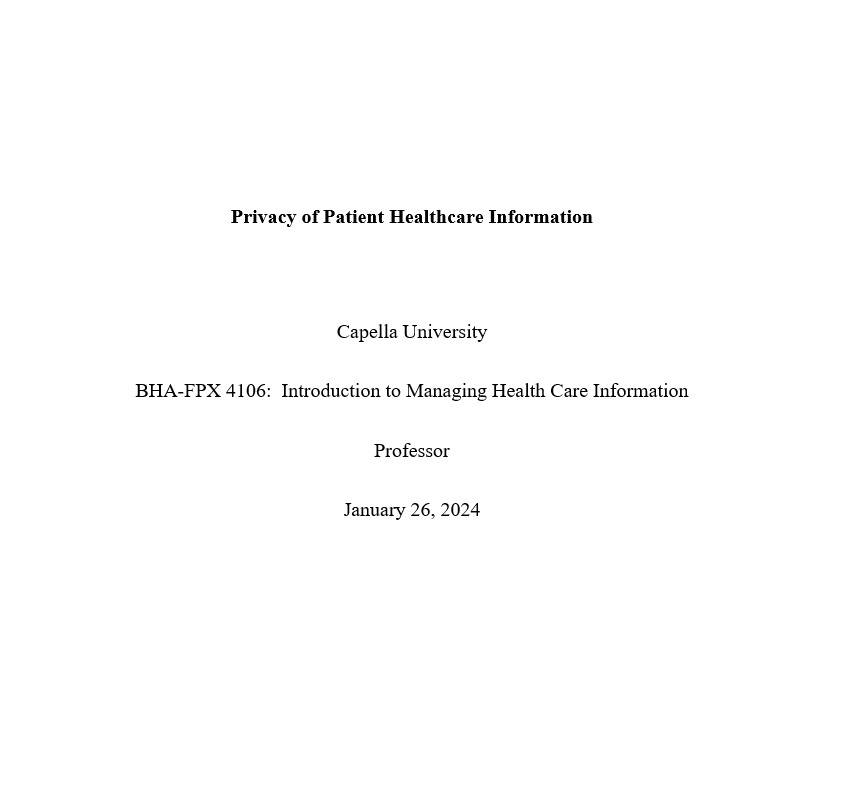Capella University
BHA-FPX 4106: Introduction to Managing Health Care Information
Professor
January 26, 2024
Privacy of Patient Healthcare Information
Introduction
The identified condition is HIV/AIDS. The chronic condition requires healthcare providers to initiate and maintain patient-centered and evidence-based care to optimize clinical experiences. Handling patients with HIV/AIDS means integrating services in a way that increases the flow of information across teams. For instance, there are interactions between the pharmacists, physicians, case managers, and others responsible for ensuring consistent adherence to treatment. Breach of confidentiality or privacy undermine the quality, cost, and safety of patient care. Exposing sensitive details such as diagnosis, disease progression, and patient’s demographic details increases the risk of stigma, prejudice, and declining physician-patient trust. Data breaches triggers negative health-seeking behavior and discontinuation of therapies, which contract requirement for healthcare providers to serve patients’ interests.
Information Collection
The patient population include men and women admitted at the facility with HIV and related complications. The demographic details include patients above 55 years and require interprofessional attention to improve symptoms. The information system that best provided the needed information is Electronic Health Record (EHR). The system support organization shift from paper patient records, which means that the care team collects and stores patient health information, HIV test results, physician visits, and treatment electronically. The specific documentation sought are details of physician and specialist visits. However, it is also vital to review information for admission and treatments for a broader understanding of the patient’s status and patient-centered interventions necessary to optimize care outcomes. Similarly, reviewing patients treated between 2020 and 2022 and those aged above 55 enhances the likelihood of making informed conclusions in adherence to data security measures.
The type of documentation for review include progress notes, lab results, and treatments. Others are patient medical histories, discharge summaries, hospital admissions, medication reviews, and contact tracing. On the source of the information needed, computerized physician order entry (CPOE) is the ideal option. The system allow physicians to enter and share treatment details such as HIV medications, lab results, and radiology orders through electronic means (Abouelmehdi et al., 2018). Efficiency in sending information and a collaborative model involving the pharmacy, laboratory, and radiology departments make the system relevant for monitoring security of information flow within the facility. The type of system used is clinical since the primary focus is on preventing disclosure of sensitive details about patients’ HIV diagnosis, treatment, and progress. The system also networks with others such as pharmacy and radiology for collaborative commitment to addressing patients’ needs.
Information Life Cycle
The information collection process will involve physicians, nurses, pharmacists, and others recording patient’s details in the facility’s EHR. The identified members of the care team are responsible for documenting the details across the continuum. For storage, the various details will be in the electronic health records. From the beginning of patient contact, all information must be coded and put underneath a pseudonym, the matching of which is under heavy security and available only to certain office members under heavy security who have been trained in security and sworn to privacy practices with any breaches punishable by termination or by law.
Controlling access to the information is another priority for the care team. In this case, all information that goes through a doctor’s office must be reviewed, including hospital stays, test results, treatment, and progress reports. All information must be kept under the patient pseudonym. Any documentation that contains the patient’s real name must be kept under lock and key, with only one or two staffers having access to that information with keys (Abouelmehdi et al., 2018). Patient information should be protected under numerous passwords that are changed often and available only to those specific office members who have been trained and sworn to privacy.
To ensure the documentation meets interoperability standards, it is crucial to ensure that systems exchange information efficiently and securely. One consideration for meeting interoperability standards is ensuring that information exchanged is accessible by only authorized users (Sorbie, 2020). Similarly, meting interoperability standards will require automation of patient admission, discharge details, and other relevant details
Integrating office information with an HIE has advantages and disadvantages. Health information exchange facilitates the sharing of patient-level health information between doctors, nurses, pharmacists, other health care providers. Integrating information with an HIE enhances efficiencies in the delivery of health care due to the speed and safety of information flow. Another advantage is that HIE prevents costly redundant tests ordered because one provider does not have access to the clinical information stored at another provider’s location. Further, integrating the office information with an HIE enhances compliance with provisions of the Health Information Technology for Economic and Clinical Health Act (HITECH). The care team understand obligations towards securing protected health information. The group understands consequences of violations, which encourages everyone to uphold values, behaviors, and attitudes for sustaining desired culture.
Disadvantages include uncertainty and reluctance by members of the care team to accept HIE or the integration. The lack of clarity for differences in rules across HIEs could lead to privacy and compliance issues with adverse implications on the organization. Strict EHRs standards are vital to overcome the risk of data security infringement (Rumisha et al., 2020). Challenges regarding the standardization of health information include the risk of insufficient implementation of existing or required standards. The situation trigger inefficient use of healthcare resources and difficulties adjusting to events in a complex and ever changing health care system.
Destroying information is also vital to enhance quality and safety of patient health information. PHI that is paper or physical should be shredded, burned, pulped, or pulverized that the refuse is indecipherable and cannot be put back together. According to Oachs and Watters (2020), overwriting PHI or degaussing help prevent the risk of unauthorized access to sensitive data.
Legal Considerations and a Plan for Compliance
Confidentiality and security measures remind healthcare professionals about the duty to take responsible steps to keep patient details confidential. Keeping information out of reach is a priority that makes everyone extra vigilant when handling sensitive information (Tariq & Hackert, 2020). Similarly, members of the care team should identify parties with authorization and permission to access to discuss protected health information (Sorbie, 2020). Further, training and education make everyone responsive to calls for confidential information. HIPAA security rule includes administrative, technical, and physical safeguards to ensure data integrity and confidentiality. Security measures include risks assessment, workforce training, and access controls appropriate for ensuring data integrity.
Any patient information that could be used to personally identify a patient divulges PHI and should thus be protected. Some information might not be part of PHI, such as test results that do not divulge any information about the patient. This result might be printed out on a piece of paper with no other identifying information with private information orally communicated to the doctor, or the only information available being the pseudonym of the patient. Any PHI used in the medical environment should be destroyed as soon as it is done being used. PHI entered into an EHI should be filed under a pseudonym and be subject to all security rules.
Conclusion
To summarize, all PHI and HIE should be analyzed semi-annually to be certain that patient data is private and cannot be accidentally or easily made accessible. In addition, all patient data should be reviewed to be sure it follows HIPAA policy. HIPAA rules guide all healthcare professionals to adhere to standards, guidelines, and procedures on securing protected health information across the continuum.
References
Abouelmehdi, K., Beni-Hessane, A., & Khaloufi, H. (2018). Big healthcare data: Preserving security and privacy. Journal of Big Data, 5(1), 1-18. https://journalofbigdata.springeropen.com/articles/10.1186/s40537-017-0110-7
Oachs, P. K., & Watters, A. L. (2020). Health information management: Concepts, principles, and practice (6th ed.). AHIMA Press.
Rumisha, S. F., Lyimo, E. P., Mremi, I. R., Tungu, P. K., Mwingira, V. S., Mbata, D., Malekia, S. E., Joachim, C., & Mboera, L. E. G. (2020). Data quality of the routine health management information system at the primary healthcare facility and district levels in Tanzania. BMC Medical Informatics and Decision Making, 20, 1-22. https://bmcmedinformdecismak.biomedcentral.com/articles/10.1186/s12911-020-01366-w
Sorbie, A. (2020). Sharing confidential health data for research purposes in the UK: Where are ‘publics’ in the public interest? Evidence & Policy, 16(2), 249-265. https://bristoluniversitypressdigital.com/doi/10.1332/174426419X15578209726839
Tariq, R. A., & Hackert, P. B. (2020). Patient confidentiality. StatPearls Publishing, 20. http://www.ncbi.nlm.nih.gov/books/NBK519540/



